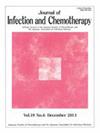Endoscopic findings among healthy adults with asymptomatic norovirus infection in Japan: A single-center cross-sectional study
IF 1.9
4区 医学
Q3 INFECTIOUS DISEASES
引用次数: 0
Abstract
Introduction
Norovirus infection, a major cause of acute viral gastroenteritis, is commonly reported during the winter season. Norovirus invades the upper intestinal tract, causing inflammation. In severe cases, endoscopic findings and complications, including duodenal perforation, have been reported. However endoscopic findings in patients with asymptomatic infections have rarely been reported. Therefore, this study aimed to investigate the upper endoscopic findings of patients with asymptomatic norovirus infection.
Methods
Healthy adults (aged ≥18 years) who participated in voluntary health examinations between February 2017 and January 2018 were recruited twice a week. Only the individuals who had undergone esophagogastroduodenoscopy (EGD) were included. The primary outcome measure was the presence of any gross findings of EGD.
Results
The norovirus genogroup I (GI)-positive group had more duodenal scarring than the norovirus negative group (16.3 % vs 5.9 %, respectively). After adjustment for age category, sex, and alcohol consumption status, duodenal ulcer scarring exhibited a significant association with GI-positive status (adjusted odds ratio: 3.11; 95 % confidence interval: 1.42–6.82; p = 0.005, Bonferroni-corrected, p = 0.015).
Conclusions
Healthy adults with asymptomatic norovirus (GI-positive) infection showed predominantly more duodenal ulcer scarring than the norovirus-negative group on EGD.
日本无症状诺如病毒感染的健康成人的内镜检查结果:一项单中心横断面研究
诺如病毒感染是急性病毒性肠胃炎的主要原因,通常在冬季报告。诺如病毒侵入上肠道,引起炎症。在严重的病例中,内镜检查结果和并发症,包括十二指肠穿孔,已被报道。然而,无症状感染患者的内窥镜检查结果很少被报道。因此,本研究旨在探讨无症状诺如病毒感染患者的上内镜表现。方法招募2017年2月至2018年1月期间参加自愿健康检查的健康成人(年龄≥18岁),每周2次。仅包括接受食管胃十二指肠镜检查(EGD)的个体。主要结局指标是是否存在EGD的总体发现。结果诺如病毒基因I组(GI)阳性组十二指肠瘢痕发生率高于诺如病毒阴性组(分别为16.3%和5.9%)。在调整了年龄、性别和饮酒状况后,十二指肠溃疡瘢痕形成与gi阳性状态显著相关(校正优势比:3.11;95%置信区间:1.42-6.82;p = 0.005,经bonferroni校正,p = 0.015)。结论无症状诺如病毒(gi -阳性)感染的健康成人十二指肠溃疡瘢痕明显多于诺如病毒阴性组。
本文章由计算机程序翻译,如有差异,请以英文原文为准。
求助全文
约1分钟内获得全文
求助全文
来源期刊

Journal of Infection and Chemotherapy
INFECTIOUS DISEASES-PHARMACOLOGY & PHARMACY
CiteScore
4.10
自引率
4.50%
发文量
303
审稿时长
47 days
期刊介绍:
The Journal of Infection and Chemotherapy (JIC) — official journal of the Japanese Society of Chemotherapy and The Japanese Association for Infectious Diseases — welcomes original papers, laboratory or clinical, as well as case reports, notes, committee reports, surveillance and guidelines from all parts of the world on all aspects of chemotherapy, covering the pathogenesis, diagnosis, treatment, and control of infection, including treatment with anticancer drugs. Experimental studies on animal models and pharmacokinetics, and reports on epidemiology and clinical trials are particularly welcome.
 求助内容:
求助内容: 应助结果提醒方式:
应助结果提醒方式:


